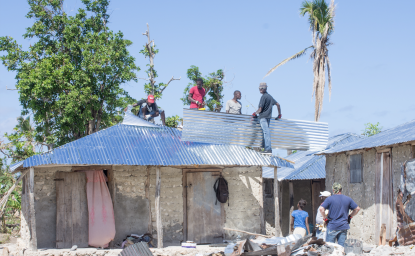Report From Johannesburg: W(h)ither Population, Environmental Change, and Security? by Geoffrey Dabelko
Burning the Bridge to the 21st Century: The End of the Era of Integrated Conferences? by Frederick A.B. Meyerson
Report From Johannesburg: W(h)ither Population, Environmental Change, and Security?
By Geoffrey D. Dabelko, director of the Woodrow Wilson Center's Environmental Change and Security Project (ECSP).
Along with over 100 heads of state and government and tens of thousands of others, I attended the World Summit on Sustainable Development in Johannesburg, South Africa in late August and early September. The conference was about numerous things: its ground-up approach to agenda-setting guaranteed that many—perhaps too many—topics were up for discussion. Delegates agreed to courses of action on everything from poverty and water resources to energy, governance, and ecosystems.
But Johannesburg also neglected a number of key topics. It only glancingly addressed contentious yet critical challenges such as population dynamics or the deeper linkages among the environment, development, and foreign and security policy. And despite all the discussion since September 11 of the underlying causes of terrorism, few at the conference even mentioned the attacks. Johannesburg showed both the productiveness of policy mega-conferences as well as their limitations in dealing with politically sensitive or multi-causal issues.
New Prominence: Trade, Health, and Water
All parties to the negotiations agreed this Summit needed to be about "action" and "implementation"—action on the ground. Delegates focused on partnerships, many of them between the public and private sectors, as a critical and neglected mechanism for working towards sustainable development. While the emergence of such partnerships drew substantial criticism before and during the conference, they should be applauded: they represent the kinds of integration and cooperation on sustainable-development issues that are often hailed but rarely achieved. But we should remain vigilant that partnerships do not merely become a means for national governments to shirk financial obligations while increasing the influence of narrow private-sector interests.
Trade enjoyed a higher profile than it did ten years ago at the Rio Earth Summit, as Johannesburg followed on the heels of world summits for a new round of trade negotiations (Doha) and financing for development (Monterrey). Health also continued its recent momentum in galvanizing the attention of national governments. For example, the new Global Fund to Fight AIDS, Tuberculosis, and Malaria was widely praised in Johannesburg as an innovative funding mechanism for action. Most dramatically, fresh water and sanitation sat atop the Summit agenda. Delegates expended considerable negotiating energy agreeing to what amounts to a new UN Millennium Goal of cutting the number of people without access to sanitation in half by 2015.
Still Missing in Action
But population and reproductive health once again were left off the explicit agenda at Johannesburg, a conference originally intended to mark the anniversaries of the 1972 Stockholm and 1992 Rio environment and development summits. Population and reproductive health did become points of contention late in the second week of Summit negotiations, as women's rights to make reproductive-health decisions became one of the final obstacles to an agreement. In the end, the compromise language in the Summit's final Plan of Implementation draft allowed both sides to claim victory—but diluted the human-rights-based consensus on women's reproductive health achieved eight years ago at Cairo's International Conference on Population and Development.
Climate change was formally left off the agenda in an attempt to entice U.S. President George Bush to attend the Summit—an all-consuming goal of the organizers in the months prior to the meeting. But despite its official absence, climate kept popping up in the hallways and at the press briefings, with NGOs and governments making political announcements on ratifying the Kyoto Protocol. The pronouncements often highlighted the United States' dual "no-shows": the absence of U.S. engagement on climate change, and President Bush's decision to vacation at his ranch in Crawford, Texas rather than appear in Johannesburg. The perceived American "go it alone" unilateralism on both climate and Iraq contributed to the generally critical reception given the U.S. delegation on a broad range of issues.
Silence on Terrorism
As for terrorism, the Summit clearly could not have been framed as a response to the attacks on New York and Washington. To do so would have overshadowed efforts to address the critical economic, social, and environmental issues that make up the sustainable-development challenge. Such a framing could also have generated more "us versus them" responses rather than the cooperation required to address these interlocking problems. Yet recent statements by senior international and U.S. officials would seem to argue that some foundational discussion of the 9/11 context was warranted at Johannesburg.
For example, before March's UN Financing for Development conference in Monterrey, World Bank President James Wolfensohn said that addressing poverty increases security and should represent part of a multi-pronged response to 9/11. Secretary of State Colin Powell wrote in an article just before the Summit that "[S]ustainable development is also a security imperative. Poverty, environmental degradation and despair are destroyers—of people, of societies, of nations. This unholy trinity can destabilize countries, even entire regions." Even President George Bush, in his pre-Monterrey announcement of a $5 billion annual increase of U.S. foreign assistance by 2006, also couched the investment in security terms.
As we have found time and time again, rhetorical commitment to linking environment and security issues is far easier to produce than practical plans of action for population, environment, and security programs. And of course, one cannot draw a direct line back from specific terrorist acts to poverty, inequity, poor health, corrupt governance, and degraded environments. But as the world continues to respond to the September 11 attacks, is it not shortsighted and counterproductive for the United States to forego even just the political benefits—let alone the humanitarian and development benefits—that would accrue from addressing these day-to-day survival challenges for literally billions worldwide?
The silence at Johannesburg may indicate that the U.S. response to terrorism will be largely unidimensional — force. Yet the past year and the rhetoric of many at the Summit reveal that many outside the United States who deplore the terrorists' methods also see underlying grievances as part of terrorism's causes. For example, Summit delegates almost universally focused on poverty as a primary issue. Yet the Europeans and G77/China representatives rarely cast these efforts within a human or military security context. German Deputy Minister for Environment Gila Altmann was an exception. In a prepared speech delivered at the Summit, Altmann cited the conflict potential of environmental degradation and unsustainable consumption of resources while also suggesting that "cross-border or regional environment and development projects are particularly suited for developing ‘confidence-building processes' between neighboring states and within regions marked by tensions and conflicts."
The Summit's final Plan of Implementation did include mention of terrorism as an inhibitor to sustainable development. But policymakers need to consider the reverse—how the lack of sustainable development contributes to deprivation and grievance and may at times underlie instability and conflict. Such a sentiment was included in the Summit's short Political Statement, in which delegates agreed that "[t]he deep fault line that divides human society between the rich and the poor and the ever-increasing gap between the developed and developing worlds pose a major threat to global prosperity, security and stability."
Water and Peacemaking
The Summit's heavy stress on water offers an example of how addressing environment issues can support peace. Vibrant and appropriate water management institutions have offered real success stories of cooperation over potentially conflictual water-resource situations. The Nile River, commonly cited as a primary "water war" candidate, is currently the subject of on-going and relatively successful negotiations among all Nile Basin governments.
The European Union's new Water for Life Initiative, announced at Johannesburg, explicitly cites human security goals into its evolving plan of action in developing countries. However, unlike resource or sectoral issues, these conservation-peace efforts did not have a unifying theme, specific actions, or a clear patron to integrate them into the implementation of Summit agreements. The segregated sectoral approach to the Johannesburg agenda (water, energy, biodiversity, agriculture, and health) did not lend itself to cross-cutting programs with multiple goals (environmental, economic, political, and security).
The breadth of the agenda, the sheer number of delegates, the scattered venues, and the unrealistic expectations made the Johannesburg Summit a commonly frustrating experience for attendees and observers. One can legitimately raise questions about the opportunity costs of the energy and resources expended on such United Nations mega-conferences, consensus documents, and agreed targets and timetables for action.
But for anyone interested in environment, population, and security linkages, the Summit afforded tremendous learning and networking opportunities—such as the Environment, Development, and Sustainable Peace Initiative's roundtable on bridging Northern and Southern perspectives on human security. Ultimately, it will be the quality of action after Johannesburg — its oft-cited implementation — that will be the Summit's measure of success.
Burning the Bridge to the 21st Century: The End of the Era of Integrated Conferences?
By Frederick A.B. Meyerson,
Ph.D., JD, is an ecologist and demographer at Brown University and a 2001-2003 AAAS Science and Technology Policy Fellow at the National Science Foundation and U.S. EPA. His research focuses on the interactions among population, environment, climate change, biodiversity, and related policy. The views expressed herein are solely his own.
At an exciting time when science may be on the verge of merging diverse disciplines and data-sets towards an understanding of the complex interactions among population, development, and the environment, we appear to be moving backwards in terms of integrated international conferences that lead to action on these issues. Prior to the recent Johannesburg World Summit in Sustainable Development (WSSD), its chairman Emil Salim remarked that the Summit would likely be the last of its kind. Others in the U.S. government and the NGO community made similar assessments after the close of the conference. While global environmental challenges are clearer and more pressing than ever, the international community seems less capable of constructive agreement and action.
On the climate front, there is finally nearly universal agreement among scientists that the earth's surface temperature is warming significantly, that the warming is likely due to human activity, and that the consequences of surface warming will have a substantial negative impact on humans and other species. Yet the poorly conceived Kyoto Protocol has been watered down, burdened with fuzzy math, and rejected by the United States—to the point where it "does not do much of anything for the atmosphere," according to Eileen Clausen, President of the Pew Center on Global Climate Change.
Only a handful of countries are on track to meet their Kyoto obligations. After more than a decade and hundreds of climate conferences and meetings involving long-term investments by thousands of academics and policymakers, the result appears to be capitulation. A recent Worldwatch paper concluded that "the gap between climate science and policy has widened, rather than narrowed, since Rio." The most recent round of climate talks in October 2002 shifted the emphasis away from preventing climate change to ways to adapt to it.
The same acceptance and malaise may now be affecting international population policy. The 1994 Cairo agreement set forth bold goals for universal access to reproductive health by 2015. Cairo +10, scheduled for early 2004, was to be a reaffirmation of those goals and assessment of progress to date. However, it now appears that the 2004 conference will be only a low-key event with minimal expectations for new actions or pronouncements. Instead of resembling the ministerial level conferences of the 1970s, 1980s, and 1990s, it is more likely to hearken back to the meetings of the 1950s and 1960s, in which population experts met to review the demographic data and trends rather than to change the future.
With little more than a year to go before Cairo +10 opens in early 2004, UN Web sites are devoid of any information concerning preparations for the meeting. Because successful international conferences require long lead times and multiple preparatory events to create new agreements, this lack of public preparation is an indication that the 2004 conference will be descriptive rather than prescriptive, reporting progress since Cairo rather than creating new mechanisms for action. The role of NGOs at Cairo +10 could well be limited to separate press conferences and side events of the sort that garner little press and have no significant effect on the official proceedings. More surprisingly, the NGO community—particularly population-environment organizations—thus far seems to be accepting this diminished role without putting up a fight.
If the international community were on track to fulfill the Cairo goals, a subdued 2004 conference would not be of great concern and perhaps even appropriate. In reality, however, almost all donor countries have fallen far short of their Cairo commitments. For instance, U.S. international family planning contributions have fallen by about 35 percent in constant dollar terms since 1995, so that the United States is providing less than half of its estimated share as agreed to in Cairo. The international donor community actually supplied fewer condoms in 2000 than it did in 1990 (950 million vs. 970 million), at a time when the current need of 8 billion condoms is expected to rise to 18.6 billion by 2015. An estimated 14,000 people become infected with HIV every day, many of them for want of a condom that can be produced for three cents.
Some have suggested that the UN is taking a low-profile approach to Cairo +10 because it is now focused on the Millennium Development Goals. Yet those goals— which include maternal health and child mortality reductions—do not include reproductive health. Another theory is that conference fatigue has overcome the UN system and the international community after so many huge circus-like events and ambitious ideas that have not reached fruition.
Others suggest that the international political climate has soured to the point that it would be too risky to reopen the Cairo goals for broad discussion, out of concern that the result would be another Mexico City and a step backward rather than forward. This "Pandora's box" fear may be well-founded. The American delegation to an October 2002 Bangkok population conference suddenly announced that the United States would not reaffirm its support for Cairo unless the terms "reproductive health services" and "reproductive rights," which can be construed to include abortion, were removed from the text.
Rio and Cairo both held out the promise that the links between population and environment could be explored scientifically, and that these relationships might be prominent enough at the 2002 and 2004 conferences to shape policy on both fronts. Instead, population and reproductive health were almost absent at Johannesburg, and environment may be completely omitted from consideration at Cairo +10. Moreover, the population-environment community seems to be oddly complacent about this turn of events.
Perhaps we will look back at the last three decades of the 20th century as a brief golden era of international cooperation on environment, population, and development. The environmental conference in Stockholm in 1972 and population conference in Bucharest in 1974 ushered in an era of constructive, high-level engagement between governments and the scientific and NGO communities. It could be that the stalemate of the Cold War and the lull afterwards produced a calm that permitted the extraordinary results of Rio, Cairo, and their predecessors. Whatever the cause of this success, now that we have crossed the bridge to the 21st century, we may wish that we could go back. We should at least try to keep the bridge from burning.
Three recommendations come to mind. First, the Cairo goals—particularly the reproductive health goals—should be specifically referenced and reaffirmed in the UN Millennium Development Goals process. Second, Cairo +10 should be more than just an experts' meeting. It should offer the opportunity and responsibility for governments, scientists, and the NGO community to jointly explore national and international successes and failures since 1994, and to revise the strategy for reaching the Cairo goals as appropriate.
Finally, Cairo +10 should be used as an opportunity to integrate the Rio, Cairo, and Johannesburg nexus between population and environmental goals, and to harmonize and coordinate those goals. This will require specifically including the environmental science and policy community at Cairo +10, as well as creating a true two-way street between population and environment research and action. In an era when science is being fully integrated, we should not allow another critical policy decade to slip by.
Related Links




